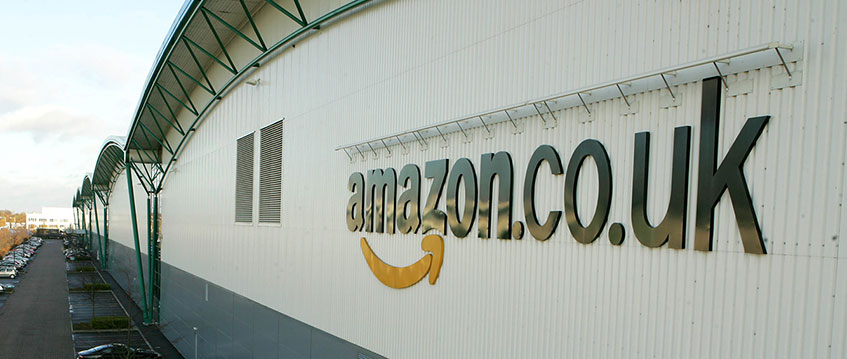Has industrial passed its peak?
Warehouse owners and developers are facing fresh challenges as industry bellwether Amazon puts the brakes on its years-long expansion drive, but they have played down unease that the market has peaked.
After posting a $3.8bn (£3bn) net loss for Q1 this year, Andy Jassy, chief executive of Amazon, said the online giant is “no longer chasing physical or staffing capacity”, turning its attentions instead to improving cost efficiencies in its fulfilment network.
Although Amazon’s strategy appeared to be skewed towards the US market, it drove down share prices at some of the UK’s biggest listed industrial players (see chart) after the markets opened on 3 May. FTSE 100 player SEGRO’s share price fell by some 10% during Tuesday’s trading.
Warehouse owners and developers are facing fresh challenges as industry bellwether Amazon puts the brakes on its years-long expansion drive, but they have played down unease that the market has peaked.
After posting a $3.8bn (£3bn) net loss for Q1 this year, Andy Jassy, chief executive of Amazon, said the online giant is “no longer chasing physical or staffing capacity”, turning its attentions instead to improving cost efficiencies in its fulfilment network.
Although Amazon’s strategy appeared to be skewed towards the US market, it drove down share prices at some of the UK’s biggest listed industrial players (see chart) after the markets opened on 3 May. FTSE 100 player SEGRO’s share price fell by some 10% during Tuesday’s trading.
Despite this, some industrial developers have stayed upbeat that their pipelines will deliver profits as expected. In Tritax Big Box’s trading update this week, the REIT highlighted that it is “on track” to deliver 3m-4m sq ft of starts this year and that rental growth should help offset cost inflation.
Ekaterina Avdonina, chief executive of KKR-backed industrial developer Mirastar, which has a 1.5m sq ft pipeline under construction, told EG there had been an “unjustified” market overreaction to Amazon’s stated aims.
“There are a lot of macro risks that we are more concerned about, such as the rising interest rates, inflation and dropping consumer confidence,” said Avdonina. “Amazon has actually been slowing down for a while, if you look at the data – the market has delivered the best performance we have ever seen, without Amazon.
“To me, that is the sign of a more mature market – and there are a lot of other large e-commerce players, manufacturers and suppliers that do not rely on Amazon’s network.”
Avdonina said the fact that Amazon is cooling its bricks-and-mortar tactics will not affect Mirastar’s investment strategy. “The slowdown from one occupier, from our perspective, will not have a profound effect on such an established market,” she said.
Even if those macro risks do create a slowdown, it will be from “extraordinary” peak levels, said Avdonina. “If occupier demand dips by 10-15%, that is still way above the 10-year average,” she said.
“Considering vacancy rates in the market, which are close to 2%, we are in a very different place. Weirdly, it could even be a good thing for stabilising the market – maybe it would cool off construction cost inflation.”
Industry leaders also highlighted Savills’ research showing Amazon accounted for just 3% of warehousing take-up during Q1 this year – in a record quarter for overall take-up.
Andrew Jones, chief executive at LondonMetric Property, which saw its share price fall by 5.5% after the markets opened on Tuesday, said the REIT was “superbly confident” that more growth will come.
“It took 25 years for Amazon to build its platform and in the last 24 months they have doubled it,” he said. “It doesn’t take Sherlock to work out that at some point they were going to dial down their square footage requirements; albeit not necessarily the number of depots they require.”
Amazon’s dialled-down big-box requirements might affect the risk profile on some speculative developments, Jones added, but “on the good ones” there is a depth of other demand that will absorb this space, with most likely higher rental levels. And even if industrial rents slow down, the sector will still outperform others.
“Ignoring Amazon, we have seen great demand from companies looking to improve their platforms to compete with Amazon as well as other occupiers looking to onshore more of their operations and also from those looking to operate with greater inventories within the UK,” said Jones.
LondonMetric’s own portfolio, which leans more on smaller-box urban logistics than big-box players, is seeing strong demand from a diverse range, including dark kitchens, Q-commerce, trade kitchens, micro-breweries and pharma distributors.
Tim Vallance, head of UK investor services at JLL, noted that Amazon has been making a loss since Q4, so the “writing has been on the wall for a while”. However, he said it would be too much of a stretch to conclude that the market has peaked. To him, it has plateaued in the face of a slowdown in online spending and geopolitical disruption, but the long-term trend is still “upwards”.
“This is a structural change and Amazon has shown the way,” said Vallance. He added that there are some lessons from retail that sheds players should start applying. “Demand is still there and the consumer won’t let it stop. But it’s a time for logistics owners to check that the rents are sustainable and that their occupiers can make a profit in the buildings they are using.
“You only have to look at what has happened in retail. Do all the checks and balances that weren’t done in retail – how much space is actually required and what the best occupiers to have in your properties are.”
To send feedback, e-mail pui-guan.man@eg.co.uk or tweet @PuiGuanM or @EGPropertyNews
Photo © Nti Media Ltd/Shutterstock











